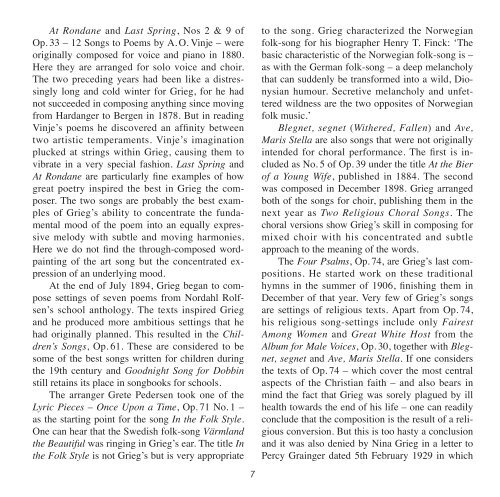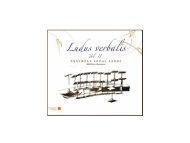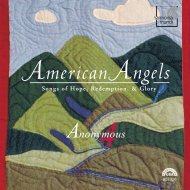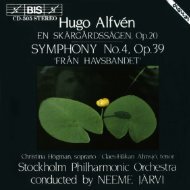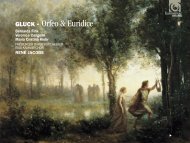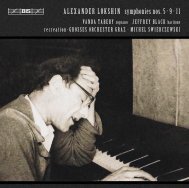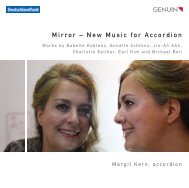EDVARD GRIEG CHOIR MUSIC - eClassical
EDVARD GRIEG CHOIR MUSIC - eClassical
EDVARD GRIEG CHOIR MUSIC - eClassical
You also want an ePaper? Increase the reach of your titles
YUMPU automatically turns print PDFs into web optimized ePapers that Google loves.
At Rondane and Last Spring, Nos 2 & 9 of<br />
Op. 33 – 12 Songs to Poems by A. O. Vinje – were<br />
originally composed for voice and piano in 1880.<br />
Here they are arranged for solo voice and choir.<br />
The two preceding years had been like a dis tres -<br />
singly long and cold winter for Grieg, for he had<br />
not succeeded in composing anything since moving<br />
from Hardanger to Bergen in 1878. But in reading<br />
Vinje’s poems he discovered an affinity between<br />
two artistic temperaments. Vinje’s imagination<br />
plucked at strings within Grieg, causing them to<br />
vibrate in a very special fashion. Last Spring and<br />
At Rondane are particularly fine examples of how<br />
great poetry inspired the best in Grieg the com -<br />
poser. The two songs are probably the best exam -<br />
ples of Grieg’s ability to concentrate the funda -<br />
mental mood of the poem into an equally expres -<br />
sive melody with subtle and moving harmonies.<br />
Here we do not find the through-composed wordpainting<br />
of the art song but the concentrated ex -<br />
pres sion of an underlying mood.<br />
At the end of July 1894, Grieg began to com -<br />
pose settings of seven poems from Nordahl Rolf -<br />
sen’s school anthology. The texts inspired Grieg<br />
and he produced more ambitious settings that he<br />
had originally planned. This resulted in the Chil -<br />
dren’s Songs, Op. 61. These are considered to be<br />
some of the best songs written for children during<br />
the 19th century and Goodnight Song for Dobbin<br />
still re tains its place in songbooks for schools.<br />
The arranger Grete Pedersen took one of the<br />
Lyric Pieces – Once Upon a Time, Op. 71 No. 1 –<br />
as the starting point for the song In the Folk Style.<br />
One can hear that the Swedish folk-song Värmland<br />
the Beautiful was ring ing in Grieg’s ear. The title In<br />
the Folk Style is not Grieg’s but is very appropriate<br />
7<br />
to the song. Grieg characterized the Norwegian<br />
folk-song for his bio grapher Henry T. Finck: ‘The<br />
basic characteristic of the Norwegian folk-song is –<br />
as with the Ger man folk-song – a deep melancholy<br />
that can sud denly be transformed into a wild, Dio -<br />
ny sian hum our. Secretive melancholy and un fet -<br />
tered wildness are the two opposites of Norwegian<br />
folk music.’<br />
Blegnet, segnet (Withered, Fallen) and Ave,<br />
Maris Stella are also songs that were not originally<br />
in tend ed for choral performance. The first is in -<br />
clud ed as No. 5 of Op. 39 under the title At the Bier<br />
of a Young Wife, published in 1884. The sec ond<br />
was composed in December 1898. Grieg arranged<br />
both of the songs for choir, publishing them in the<br />
next year as Two Religious Choral Songs. The<br />
choral ver sions show Grieg’s skill in com pos ing for<br />
mixed choir with his concentrated and subtle<br />
approach to the meaning of the words.<br />
The Four Psalms, Op. 74, are Grieg’s last com -<br />
positions. He started work on these traditional<br />
hymns in the summer of 1906, finishing them in<br />
December of that year. Very few of Grieg’s songs<br />
are settings of religious texts. Apart from Op. 74,<br />
his religious song-settings include only Fairest<br />
Among Women and Great White Host from the<br />
Album for Male Voices, Op. 30, together with Bleg -<br />
net, segnet and Ave, Maris Stella. If one considers<br />
the texts of Op. 74 – which cover the most central<br />
aspects of the Christian faith – and also bears in<br />
mind the fact that Grieg was sorely plagued by ill<br />
health towards the end of his life – one can readily<br />
conclude that the composition is the result of a rel i -<br />
gious conversion. But this is too hasty a conclusion<br />
and it was also denied by Nina Grieg in a letter to<br />
Percy Grainger dated 5th February 1929 in which


